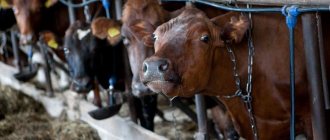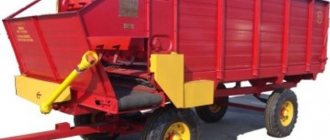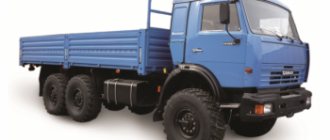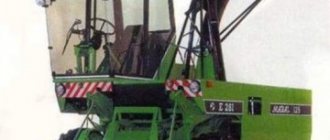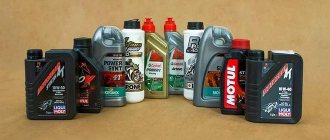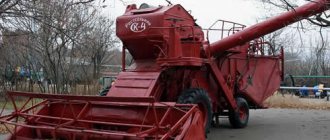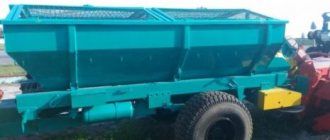Speaking about the types of machines for distributing feed, it can be noted that in its design this type of agricultural machinery is a trailed vehicle with a body, which is equipped with a system of conveyors or augers for feeding and mixing plant feed. In addition, there are models with expanded functionality, which can additionally accommodate a loading device, equipment for additional grinding of feed mass and mixing feed mixtures, hydraulically adjustable feed trays with conveyors for convenient unloading into feeders, and dosing devices for dispensing standardized doses of feed.
This article covers the topic of the model range existing on the agricultural market. equipment, livestock feed distributors.
Stationary and mobile feed dispensers for cattle: technical characteristics, photos and videos
What types of feed dispensers are there for cattle farms
? Feed dispenser - trailer
A large farm requires considerable physical effort and time.
But thanks to modern technology, many tasks, including feeding animals, can be done with the help of machines, making the activity easier and faster.
Increasingly, entrepreneurs began to provide their staff with feed dispensers for cattle farms, which significantly affects the quality of livestock feeding, thereby increasing the profitability of the business.
These units automate the work of feeding animals that was previously performed by human hands. Moreover, they provide rational and high-quality nutrition for livestock, since they regulate the distribution of food, the number of portions and the composition of the diet.
Advantages and features of feed dispensers
To simplify work on the farm, feed dispensers are now increasingly being used. The owner of an enterprise may consider it advisable to purchase such expensive equipment if his farm contains a large number of animals.
The unit has the following advantages and features:
- Grinds and prepares (if necessary) feed for livestock according to their needs.
- The mechanism has built-in dispensers that regulate the amount of food supplied to the animals. Serving size calculations can be determined by measuring the volume or weight of the food.
- Modern feed dispensers have a function that determines and regulates the temperature of the feed. Also, some types of units are connected to monitors, so you can monitor the preparation of food for livestock.
All these functions increase the cost-effectiveness of keeping the herd by controlling feed consumption. According to statistics, using such technologies it is possible to increase the percentage of annual cow milking by ten percent.
Since farming business is popular in our country, you can see very different feed dispensers on the market. It is not profitable to use them at home. However, in large industries they are necessary.
Stationary feed dispensers
Stationary mechanisms for distributing feed are distinguished by the fact that they must be installed directly in the barn, without the possibility of further transportation.
The units operate using electric motors.
Stationary mechanisms can be belt, belt-slat, belt-chain or scraper type.
The main functions of such feed dispensers are to supply portions of feed into a container provided for this purpose. With the help of a transformer, food is transported and distributed throughout all pens.
Examples of the most common feed dispensers in our country:
- KRS mechanism – 15.
- TVK dispenser – 80B.
- Single-sided tape KLO – 75.
- Tape double-sided CLC – 75.
- Dispenser used on dairy farms, RK – 50.
Mobile feed dispensers
Mobile distributors distribute and serve dry and green fodder to livestock.
Semi-liquid nutrition is provided using special mixers (often purchased from pig farms).
The mobility of the mechanism is explained by the fact that it distributes feed from the bunker, and distributes it to the feeders of all pens of the farm using dispensers, which are equipped with the function of independent movement.
The mobility of mixers working with liquid and semi-liquid mixtures is relative. This is explained by the fact that units of this type move along special tracks pre-installed on the floor surface. They can carry out their mission exclusively in one building.
An important advantage of this type of dispenser is that they mix liquid or semi-liquid feed before serving it to livestock. Thanks to this function, all animals receive food of uniform consistency.
Among the mobile feed dispensers that have earned a good reputation in our country are:
- Unit RS – 5A.
- Mechanism KS – 1.5.
- Dispenser KSP – 0.8.
- Universal action unit KTU – 10A.
- Small RMM – 5.0.
- Mixer RSP – 10.
The size and volume of the feed hopper can be selected according to the number of livestock kept on the farm. The farmer can also choose the type of unit drive that suits his case, its operating speed and level of productivity.
About the owner feed dispenser - presented in detail in the video:
Select it and press Ctrl+Enter to let us know.
Stationary
Stationary feed dispensers are installed indoors, and feed distribution is carried out by conveyors; their drive mechanism is electric. engines.
Stationary distributors for farms are divided according to the type of conveyor - belt, belt-slat, belt-chain, scraper, etc.
The essence of the feed supply process for this type of dispenser comes down to unloading feed from a hopper (mobile dispenser) onto a conveyor installed at the bottom of the trough-feeder. The conveyor moves the feed along the entire length of the room, ensuring its uniform distribution for all livestock in the room.
KRS-15
An example of a stationary feed dispenser of the scraper type is the KRS-15 of the Bratslav experimental plant, designed for transporting crushed dry and succulent stalked feed (silage, haylage, green mass), as well as feed mixtures.
KRS-15 is an open conveyor dispenser with a horizontal position; it is mounted on the bottom of a trough-feeder, consisting of two feed supply channels, ringed with each other and located parallel to each other.
Its design includes a fence, inside which a working element moves - a chain-scraper conveyor. On one side there is a conveyor drive, and on the other there is a conveyor tension device.
The operating principle of this feed dispenser is simple. From any feeding device (mobile dispenser, bunker), feed is unloaded into a fence within which the conveyor is located. Next, the conveyor drive is activated due to the electric drive. engine. The conveyor starts moving, the scraper grabs part of the feed and moves it along the fence. Since the conveyor is looped, the feed distribution process is considered complete when the first scraper that has captured the feed makes a full revolution around the ring, after which the dispenser drive is turned off.
TVK-80B
Let's consider the TVK-80B model as a tape dispenser. It consists of a chain-belt conveyor installed inside a trough-feeder. There is only one tape, looped type. On one side of the distributor there is a gear drive with electric drive. engine, and on the other - a driven drum with a belt tensioning mechanism.
Specifications
The production characteristics of these two feed dispensers are shown in the table:
As can be seen from the table, the TVK-80B feed dispenser is superior to the KRS-15 in all respects, except for the livestock served. The high rate of serviced livestock of the KRS-15 is ensured by the parallel movement of the scraper conveyor.
Mobile
Mobile feed dispensers can be used to distribute dry and succulent stem feed. Feed dispensers-mixers are often used to dispense semi-liquid feed mixtures, but in most cases they are used on pig farms.
They are mobile because feed is dispensed into trough-feeders directly from the bunker, and feed is distributed along the entire length of the room by moving the dispenser. Tractors or trucks can be used for transportation, and feed dispensers-mixers are often self-propelled.
In most cases, mixing feed dispensers are classified as conditionally mobile, since the bunker moves along tracks or on rails, installed either on the floor, or have a suspended installation indoors. The use of this type of dispenser is possible only within one room.
Unlike mobile dispensers for cattle, which transport feed in a bunker and, using conveyor belts through dispensing windows, simply unload it into feeding troughs, feed dispensers-mixers used for pig farms, before unloading the feed mixture, pre-mix it inside the bunker.
Mobile dispensers-mixers have a very similar design to each other. There is a hopper with a mixing device built into it. Feed dispensing mechanisms are connected to the bunker. The bunker is mounted on a four-wheeled cart, one axle of which is driven by an electric motor, which ensures its self-propelled movement. The electric motor also drives the mixing device and the dispensing mechanism. Such distributors are controlled by control panels, and power is supplied via a flexible cable.
RS-5A
One of such dispenser-mixers is RS-5A. This mobile unit is driven by an electric motor. His cart moves along tracks in the floor. The hopper is cylindrical and horizontal. It mixes feed using a screw mixing device with a horizontal screw arrangement, then the feed enters a double-sided screw-type feed dispensing mechanism. The control is carried out by levers, while the operator is on the trolley, with a seat provided for him.
KS-1.5
The KS-1.5 dispenser-mixer has a slightly different design. A vertical hopper is installed on the trolley. Movement around the room is carried out on rails. Inside the bunker there is a screw mixing device with a vertical screw arrangement. After mixing, the feed mixture passes through a dosing mechanism, and distribution is carried out by two screw devices. The mixing and dispensing devices are driven by an electric motor through a gearbox. The distributor is controlled by levers, the operator is positioned standing on a special platform.
Diagram of the feed dispenser KS-1.5
1-divider box; 2 — chassis; 3 - frame; 4 — device for automatically stopping the feed dispenser; 5 - motor - gearbox; 6 — unloading auger; 7 - paddle mixer; 8 - bunker; 9 - travesna; 10 - auger - mixer; 11 - leveller; 12 — control panel; 13 — electrical equipment; 14 — table of feed distribution rates; 15 — scale; 16 — steering wheel; 17 - platform for the worker
KSP-0.8
But the KSP-0.8 mixing distributor does not have a wheeled trolley; its wheel axles are attached directly to the hopper, and the distributor moves on rails.
The bunker is equipped with a horizontal screw mixer. The finished feed is also unloaded using augers. The control is lever, the operator controls the unit while standing on the platform.
Specifications
In addition to design features, the described feed dispensers-mixers also have different performance characteristics, they are listed below.
Characteristics of mobile feed mixers:
| Characteristics | Unit measurements | RS-5A | KS-1.5 | KSP-0.8 |
| Type | — | mobile | mobile | mobile |
| Drive unit | type | electric | electric | electric |
| Hopper capacity | m.cub. | 0,8 | 2 | 0,8 |
| Mixer performance | t/h | 1,8 | 4,8 | 1,6 |
| Movement speed | m/sec | 0,47 | 0,52 | 0,25 |
The video shows the operating principle of the feed mixer:
Purpose and principle of operation
A feed dispenser is a special device whose tasks include receiving, transporting and dosed distribution of feed and their mixtures. Dispensers can feed green feed, haylage, silage, unchopped haylage and forage mixtures into feeders on one or both sides.
The following requirements apply to feed dispensing devices::
- ensuring uniformity, timeliness and accuracy when distributing feed (feeding time no more than 30 minutes per room);
- dosage of forage distribution for each animal or their group (deviation from the norm is allowed for concentrated feeds - 5%, for stem feeds - 15%);
- contamination of forage is not allowed (returnable losses are no more than 1%, irrecoverable losses are not allowed);
- Segregation of feed in mixtures is not allowed;
- devices must be injury-proof for animals, including electrically safe.
Types of feed dispensers
There is a huge number of distributors, it is determined by their operating conditions, for different types and sizes of farms, for different types of animals, with varying degrees of automation, etc.
Classification of feed dispensers:
- by type of movement - stationary and mobile;
- according to the method of distribution - single- and double-sided;
- in terms of load capacity - single- and double-axle.
By way of movement
Feed dispensers used on farms can be:
- stationary — are installed inside farms, directly above or inside feeders, and in one way or another they dose out feed from the bunker, where feed or mixtures are prepared in containers. Stationary feed dispensers differ in the type of working body that transmits the forage: mechanical - conveyor, hydraulic, pneumatic and gravity. Conveyor - distinguished by the type of mechanism, belt, scraper or chain; an electric motor is usually used for drive;
- mobile - they can load up with food anywhere, deliver it to the place and distribute it among the feeders. They can be mounted on tractor trailers or trolleys (the drive to the distribution mechanisms is transmitted from the tractor) or self-propelled, placed on the frame of a car or completely autonomous, often electrically driven.
By distribution type
Feed dispensers, which are used on cattle farms, can supply food to feeders from one side or from both sides.
By load capacity
The division by carrying capacity is used for mobile dispensers and characterizes how much forage a given dispenser can transport.
As a rule, this is determined by the number of axles on tractor trailers and the carrying capacity of the vehicle chassis on which the feed dispenser is installed. The average lifting capacity of a two-axle feed dispenser is 3.5–4.2 tons, and a single-axle one is 1.1–3.0 tons.
Feed dispenser chopper mixer KIS
This brand of mixer feed dispensers is produced by the Novosibirsk Experimental Plant of Non-Standardized Equipment - Selmash. The design of the machines also has the type of chopper-mixer with a vertical turbo auger.
Single-screw trailed mixer distributor KIS
| Indicators | KIS - 8, 8a, 8B, 9 | KIS -10, 10a, 10B, |
| Body volume, m³ | 8,9 | 10 |
| Power consumption, kW | 45 | |
| Number of screws | 1 | |
| Number of knives on the auger | 7 | |
| PTO drive rotation speed, rpm | 540 | |
| Screw rotation speed, rpm | 26 | |
| Unloading height, mm | 750 | |
| Ground clearance, mm | 300 | |
| Track width, mm | 1960 | |
| Overall width, mm | 2410 | |
| Standard height, mm | 2550 | 2700 |
| Height upon request, mm | 2400-2550 | 2600-2700 |
| Weight without feed, kg | 3900 | |
Vertical turbo auger for KIS distributor mixer
Mixers can be placed on the basis of a 2-wheel single-axle chassis or a balanced 4-wheel base. Depending on the configuration, the mixture can be distributed by a conveyor belt, into the right-hand unloading window, or into both unloading side windows.
Technical characteristics and descriptions of popular models
When choosing a feed dispenser, you should take into account its characteristics. They are common for all types (productivity, feed supply speed, volume of the working hopper) and specific.
For stationary dispensers, this is the belt speed and power consumption. For mobile devices, this is the transported weight, the speed of movement during transportation and distribution, the turning radius, and overall dimensions. Both types of models are popular.
Stationary
Stationary feed dispensers are used either on large farms with feed workshops, where it is necessary to automate and optimize feed supply as much as possible, or on small farms, where it is impossible to use mobile dispensers due to the size of the premises and feeders.
The drive is supplied from an electric motor through a gearbox to a chain that drives the belt. The feed from the receiving hopper is evenly distributed with a tape along the entire feeder, after which an automatic switch installed on one of the circuit elements is activated.
Its parameters:
- feeding front length - 74 m;
- productivity - 38 t/h;
- serviced livestock - 62;
- electric motor power - 5.5 kW.
The main advantage of such a feed dispenser is the complete automation of feed distribution.
Their use is most effective in barns adjacent to the feed shop - this avoids overloading of forage, gas contamination of the premises, and ensures an optimal microclimate. KRS-15 is a stationary scraper feed dispenser for dry crushed and succulent stalked feeds, such as silage, hay, green mass, and feed mixtures.
The working part is a chain-scraper conveyor , located inside the fence, driven by an electric motor. Forage is fed from a hopper or mobile dispenser into a fence and then distributed along a chute using scrapers. The drive switches off when the first scraper has completed a full revolution.
Its parameters:
- feeding front length - 40 m;
- productivity - 15 t/h;
- livestock served - 180;
- electric motor power - 5.5 kW.
The RK-50 feed dispenser with a belt conveyor located above the feeder feeds and distributes crushed feed inside the farm.
There are two versions of this model - for 100 and 200 heads with one and two conveyor-distributors, respectively.
Advantages of using feed dispensers
The use of feed dispensers when caring for cattle provides the following advantages::
- reduces time and labor costs for distributing feed, simplifies and speeds up the feeding process;
- the use of complex preparatory feed mixers makes it possible to optimize the preparation of feed and mixtures and immediately feed them into feeders;
- the use of stationary feed dispensers allows you to automate the supply of feed and thereby optimize the daily diet of animals, which has a positive effect on their growth and productivity;
- the use of mobile dispensers allows not only to quickly distribute feed, but also to load it in the fields, in storage or production areas and deliver it to farms;
- reduces the cost of the resulting products.
Domestic manufacturers of feed dispensers are willing to cooperate with farms and customize the model to the specific conditions and requirements of the customer, which allows them to be used even more efficiently.
Feed dispensers for cattle farms KTP-10U
Feed dispensers controlled by a tractor are intended for the following types of agricultural work:
- Transportation and dosed supply of crushed feed
- Maintenance of various machines when harvesting products as a transport trailer with a self-unloading function
- Dosed supply of crushed and processed feed to the means loading it into feed storage facilities, as well as to on-farm feed distributors.
Feed dispensers designed for cattle farms supply feed to summer and walking areas for livestock, as well as to farms and livestock buildings. When carrying out transport work and distributing dry food, dispensers are used at ambient temperatures from -40 to +400C. Wet food must be distributed warm.
Distributors work in conjunction with agricultural wheeled traction tractors that have a traction coupling device, as well as a pneumatic braking system and equipment. Feed is distributed in standard livestock buildings with a gate height of at least 2.5 meters and a width of at least 2.6 meters, a passage width for distributing feed of at least 2.2 meters and a feeder side height of no more than 75 cm.
